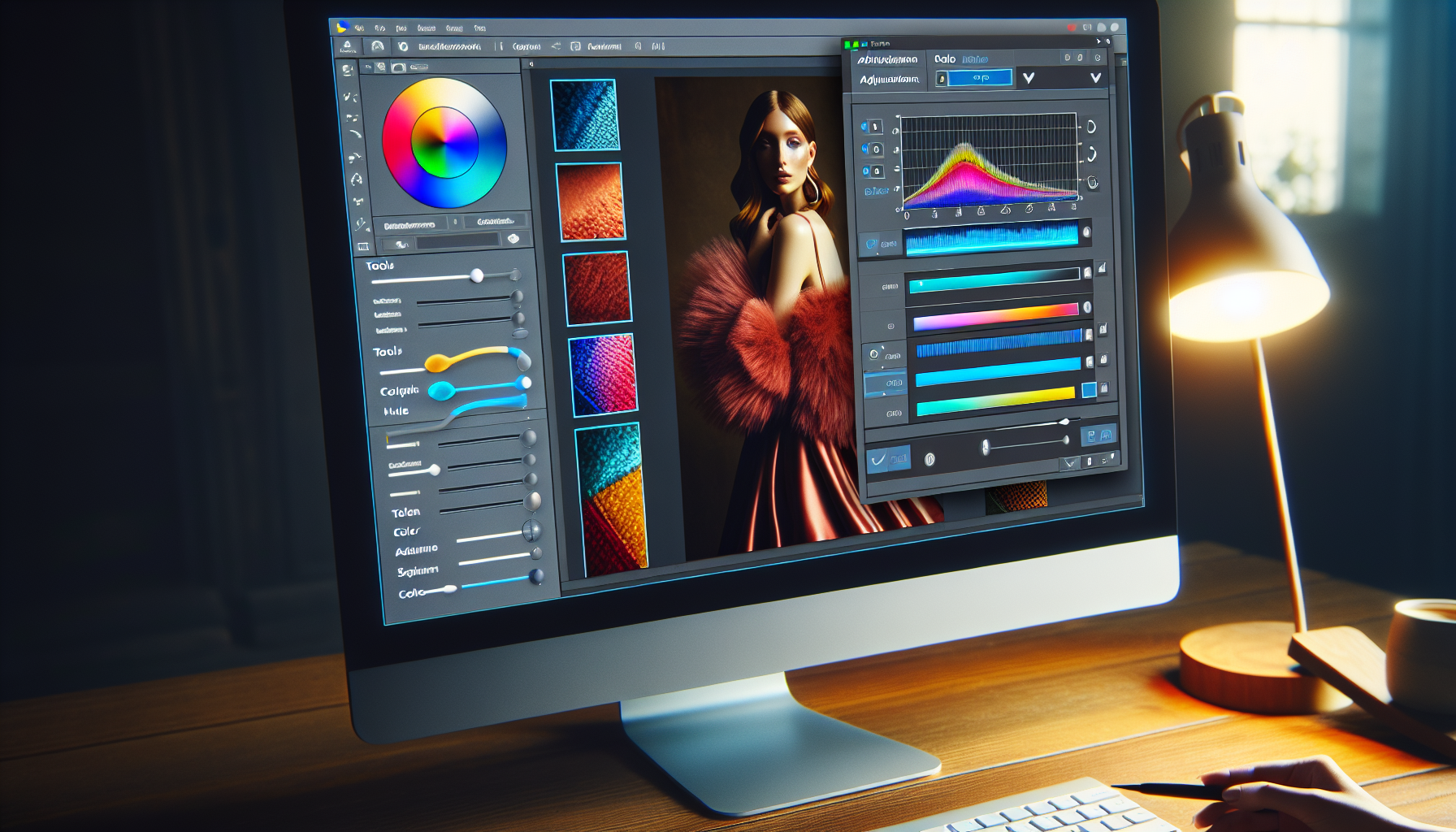
In the fast-moving world of online fashion, first impressions are everything. Your product images are often the very first interaction a potential customer has with your brand. In e-commerce, where shoppers can’t touch or try on items, these visuals must work harder than ever to capture attention, convey quality, and drive sales. For photo studios supporting the fashion e-commerce sector, this means navigating a landscape of ever-increasing demands – higher volumes, tighter deadlines, and unwavering expectations for image perfection.
The pressure is on photo studio professionals to not only deliver stunning visuals but also to do so with remarkable efficiency. The secret to success lies in a streamlined workflow, one that eliminates bottlenecks, maximizes resources, and ensures consistently high-quality results across every single product image. This article delves into the essential strategies for optimizing your e-commerce fashion photography workflow, helping you to meet the challenges of today’s market and position your studio for sustained growth and success.
Key Takeaways for Streamlining Your Fashion E-commerce Photography Workflow:
- Boost Efficiency: Learn practical methods to reduce turnaround times and get your product images online faster, accelerating time-to-market.
- Control Costs: Discover cost-effective strategies for managing your post-production process without compromising image quality.
- Elevate Image Quality: Implement techniques to ensure consistent, high-quality images that capture the essence of your fashion products and enhance brand perception.
- Scale Production Seamlessly: Develop workflows that can handle increasing volumes of images, especially during peak seasons and product launches, without added stress.
- Improve Team Collaboration: Foster better communication and feedback loops within your team and with external partners to ensure smooth operations.
- Embrace Smart Technologies: Explore how automation and specialized software can streamline tasks and free up your team for creative and strategic work.
- Focus on Brand Consistency: Establish clear brand guidelines and processes to maintain visual uniformity across all product imagery.
- Enhance Client Satisfaction: Deliver exceptional service and high-quality results that meet and exceed client expectations, building strong, lasting partnerships.
Navigating the Dynamic World of E-commerce Fashion Photography
The e-commerce fashion industry is in constant motion. Trends change in a heartbeat, new collections launch at an incredible pace, and online retailers are always looking for ways to stand out in a crowded digital space. At the heart of this visual race is product photography. High-quality, visually compelling images are no longer a ‘nice-to-have’ – they are absolutely essential for success. Shoppers online make purchasing decisions based primarily on what they see. Crisp, clear, and attractive product images are the virtual storefront, the salesperson, and the brand ambassador all rolled into one.
This puts significant pressure on e-commerce fashion photo studios. They are tasked with producing not just a few stunning shots, but vast quantities of images – often thousands per month for larger retailers. And these images must be consistently excellent, reflecting the brand’s aesthetic and accurately representing the products. Speed is also of the essence. Fast fashion demands fast turnaround times. The quicker images are processed and uploaded, the faster products can go on sale and generate revenue. Studios are constantly striving to balance volume, quality, and speed – a delicate but crucial balancing act. The need to adapt to evolving trends and technologies further complicates the landscape, demanding constant learning and process refinement.
Key Obstacles in Fashion E-commerce Photography Workflows
While the goal is always to create a smooth, efficient photography workflow, many studios encounter common hurdles that can slow them down, increase costs, and impact image quality. One major challenge is maintaining image consistency across large volumes. When dealing with hundreds or thousands of images for a single product line, ensuring that every shot adheres to brand guidelines and maintains a uniform look and feel is a complex task. Variations in lighting, styling, and post-production can easily creep in, leading to a disjointed and unprofessional presentation online.
Another significant pain point is handling high volumes with tight deadlines. E-commerce operates on a relentless cycle of new product launches and seasonal campaigns. Photo studios are often required to process massive image quantities within incredibly short timeframes. This pressure can lead to rushed work, errors, and burnout within the team. Furthermore, cost management is always a critical consideration. E-commerce businesses are often budget-conscious, and photo studios need to find ways to provide high-quality services at competitive prices. Inefficient workflows can inflate costs through wasted time, resources, and potential re-shoots or re-editing.
Brand alignment is yet another crucial aspect. Product images must accurately reflect the brand’s identity and appeal to its target audience. This requires close collaboration between the studio and the e-commerce client, clear communication of brand guidelines, and a deep understanding of the brand’s aesthetic. Finally, managing feedback and revisions can be a source of delays and frustration if not handled efficiently. Unclear communication, lengthy feedback loops, and multiple rounds of revisions can significantly impact turnaround times and project costs. Addressing these common challenges requires a strategic approach to workflow optimization, focusing on clear processes, efficient resource allocation, and smart technology adoption.
Practical Strategies to Optimize Your E-commerce Fashion Photography Workflow
Creating a streamlined workflow is not about finding a single magic solution, but rather a combination of carefully considered strategies applied across every stage of the photography process.
1. Strategic Pre-Shoot Planning and Preparation:
Efficiency starts long before the camera clicks. Detailed pre-shoot planning is paramount. This involves creating comprehensive shot lists that clearly outline every image required, including product angles, styling variations, and any specific details. Developing detailed style guides is equally important. These guides should document brand-specific requirements for lighting, backgrounds, styling, posing, and post-production aesthetics. Clear briefs, informed by these style guides and shot lists, should be provided to every member of the photography team – from photographers and stylists to retouchers – ensuring everyone is on the same page from the outset. Well-organized product samples, readily accessible and prepared for shooting, also saves valuable time on set.
2. Optimizing On-Set Efficiency:

The photoshoot itself is a critical phase for workflow optimization. Investing in the right equipment is a foundational step. Using high-quality cameras, lenses, and lighting gear reduces the need for extensive post-production adjustments. Implementing standardized set setups for different product types can dramatically speed up shoot times. Creating repeatable setups for clothing, accessories, and footwear allows for quick transitions between products and ensures consistent lighting and backgrounds. Tethered shooting, where images are directly transferred to a computer as they are captured, allows for immediate review and on-the-spot adjustments, minimizing the need for re-shoots later. Finally, efficient on-set styling and posing practices are key. Training stylists and photographers to work quickly and effectively, minimizing adjustments during shooting while maintaining quality, is crucial for maximizing on-set productivity.
3. Post-Production Workflow Streamlining:
Post-production is often the most time-consuming part of the process, and thus, offers significant opportunities for optimization. Establishing clear post-production guidelines, aligned with the brand’s style guide, is essential for consistency. These guidelines should cover all aspects of image editing, including background removal, color correction, retouching, and shadow creation. Creating and utilizing Photoshop Actions and Presets can automate repetitive editing tasks. Actions can be recorded to perform a series of steps with a single click, while presets apply consistent adjustments to color and tone, saving countless hours of manual work. Batch processing software is indispensable for handling large volumes of images. Programs like Adobe Lightroom or Capture One allow for applying adjustments to multiple images simultaneously, significantly speeding up the editing process. Consider outsourcing post-production to specialized services, particularly for high-volume, routine tasks like background removal or basic retouching. This can free up in-house retouchers to focus on more complex and creative tasks.
4. Leveraging Technology and Automation:
Technology is a powerful ally in workflow optimization. Exploring AI-powered editing tools can automate certain aspects of post-production, such as background removal and basic retouching, further boosting efficiency. Implementing a robust digital asset management (DAM) system is crucial for organizing, storing, and retrieving images efficiently. A DAM system ensures images are easily searchable, version-controlled, and readily accessible to everyone who needs them. Workflow management software designed for photo studios can help streamline project management, task assignment, and communication. These platforms often offer features like progress tracking, deadline alerts, and client communication portals. Custom-built online platforms, like the one used by Pixel By Hand, can provide a centralized hub for image uploads, feedback, and project management, facilitating seamless collaboration with clients and internal teams.
5. Effective Communication and Feedback Loops:

Clear and timely communication is the backbone of any efficient workflow. Establishing clear communication channels between the photo studio and the e-commerce client is essential. Regular updates, prompt responses to queries, and proactive communication about project status keep everyone informed and aligned. Implementing structured feedback processes is equally important. Using online proofing platforms allows clients to provide feedback directly on images, minimizing ambiguity and streamlining the revision process. Setting clear deadlines for feedback and revisions ensures projects stay on track and prevents delays. Fostering open communication within the internal studio team is also crucial. Regular team meetings, clear task assignments, and open channels for questions and problem-solving contribute to a smoother and more efficient workflow.
Case Study 1: “Studio Vivid’s” Transformation Through Workflow Optimization
“Studio Vivid,” a mid-sized photo studio specializing in fashion e-commerce photography, was struggling to keep up with the increasing demands of their clients. They were facing challenges with missed deadlines, inconsistent image quality, and rising operational costs. Recognizing the need for change, Studio Vivid embarked on a workflow optimization initiative.
Their first step was to implement detailed pre-shoot planning. They developed comprehensive style guides for each of their major clients, outlining every aspect of the required imagery. They also introduced standardized set setups and invested in tethered shooting technology. In post-production, Studio Vivid adopted batch processing software and created a library of Photoshop Actions for common editing tasks. They also began outsourcing background removal to a specialized service.
The results were significant. Studio Vivid saw a 30% reduction in turnaround times for image delivery. Image consistency improved dramatically, leading to higher client satisfaction. They also reduced their post-production costs by 15% through outsourcing and automation. By streamlining their workflow, Studio Vivid was able to take on more clients, increase their revenue, and establish themselves as a highly efficient and reliable partner in the e-commerce fashion photography industry.
Expert Opinion 1: Workflow Consultant, Elias Thorne

“In today’s fast-paced e-commerce environment, an optimized photography workflow is no longer a luxury, it’s a necessity. Photo studios that prioritize efficiency, consistency, and scalability are the ones that will thrive. By focusing on clear processes, leveraging technology, and fostering strong communication, studios can unlock significant improvements in productivity, cost-effectiveness, and client satisfaction. It’s about working smarter, not just harder, to deliver exceptional results in a demanding market.” – Elias Thorne, Principal Consultant, Photography Workflow Solutions.
The Strategic Advantage of Specializing in Post-Production Partnerships
For many e-commerce fashion photo studios, handling the entire post-production workload in-house can become a bottleneck, especially as image volumes grow. Partnering with specialized post-production services offers a strategic advantage, allowing studios to focus on their core competencies – photography and client management – while ensuring efficient and high-quality image editing.
Specialized post-production partners bring deep expertise in image retouching and enhancement, often with teams dedicated solely to this critical stage. They are equipped with the latest technologies and refined workflows designed for high-volume image processing. This expertise translates to improved efficiency and faster turnaround times. By outsourcing time-consuming tasks like background removal, color correction, and basic retouching, studios can free up their in-house retouchers to concentrate on more complex and creative editing, or even re-deploy them to other critical areas of the business.
Furthermore, outsourcing can be cost-effective. Specialized services often offer scalable pricing models, allowing studios to pay only for the services they need, when they need them. This can be particularly beneficial during peak seasons or for large projects, avoiding the need to hire and manage additional in-house staff. Partnering also provides scalability and flexibility. Studios can easily adjust their post-production capacity based on fluctuating client demands without being constrained by in-house resources. Finally, specialized partners often invest in cutting-edge technology and stay abreast of industry best practices, ensuring that studios benefit from the latest advancements in image editing techniques.
Case Study 2: “ImageCraft Studio” and the Power of Post-Production Outsourcing
“ImageCraft Studio,” a boutique fashion photography studio, initially managed all post-production in-house. However, as their client base grew, they found their in-house team overwhelmed, struggling to meet deadlines and maintain consistent quality. To address this challenge, ImageCraft Studio decided to outsource their high-volume, routine post-production tasks, such as background removal and basic retouching, to a specialized external service.
By partnering with a post-production expert, ImageCraft Studio experienced a remarkable transformation. Their post-production turnaround times decreased by 40%. Their in-house retouchers were able to focus on higher-value tasks like advanced retouching and creative image manipulation, leading to enhanced image quality and more sophisticated results. They also realized a 20% reduction in post-production operational costs. Outsourcing allowed ImageCraft Studio to scale their operations seamlessly, handle larger projects, and offer a wider range of services to their clients, significantly boosting their competitiveness in the market.
Expert Opinion 2: E-commerce Operations Strategist, Anya Petrova

“In the highly competitive e-commerce landscape, operational efficiency is paramount. Smart businesses strategically outsource non-core functions to specialized partners to optimize their resources and focus on their key strengths. For fashion photo studios, partnering with expert post-production services is a particularly intelligent move. It allows them to streamline their workflows, enhance quality, control costs, and scale effectively, ultimately contributing to improved profitability and client success. It’s about building a robust and agile operational model.” – Anya Petrova, Lead Strategist, E-commerce Operations Consulting Group.
Future-Proofing Your Workflow: Adapting to Emerging Trends
The world of e-commerce fashion photography is constantly evolving, driven by technological advancements and changing consumer expectations. To future-proof your workflow, it’s crucial to stay informed and adapt to emerging trends. Artificial Intelligence (AI) and machine learning are increasingly impacting post-production. AI-powered tools are becoming more sophisticated, automating tasks like object recognition, background removal, and even complex retouching operations. Embracing these technologies can further enhance efficiency and reduce manual workloads.
360-degree photography and 3D modeling are gaining traction, offering shoppers more immersive and interactive product experiences. Studios need to consider incorporating these services into their offerings to meet evolving client demands. Augmented Reality (AR) and Virtual Reality (VR) technologies are also emerging in e-commerce. While still in early stages, these technologies could transform how consumers interact with product images, potentially requiring studios to adapt their image creation and post-production workflows. Sustainable and ethical practices are becoming increasingly important in the fashion industry, and this extends to photography. Studios should explore eco-friendly shooting practices, minimize waste, and consider ethical sourcing of materials and services. Finally, continuous learning and adaptation are key. Staying updated on the latest industry trends, software updates, and workflow best practices is essential for maintaining a competitive edge and ensuring your studio remains at the forefront of e-commerce fashion photography.
Optimizing your e-commerce fashion photography workflow is an ongoing journey of refinement and adaptation. By prioritizing strategic planning, embracing technology, fostering clear communication, and considering specialized partnerships, photo studio professionals can create efficient, scalable, and cost-effective workflows that deliver consistently high-quality results. In a visually-driven industry where speed and quality are paramount, a streamlined workflow is not just an operational advantage – it’s the foundation for sustainable success and a key differentiator in the competitive world of e-commerce fashion. Continuously evaluate your processes, seek out areas for improvement, and remain agile in the face of evolving industry demands to ensure your studio remains a trusted and valuable partner for fashion e-commerce brands.